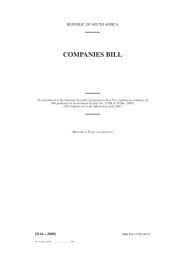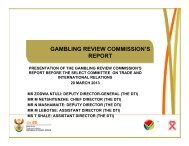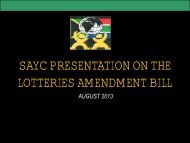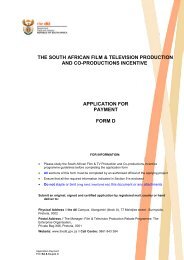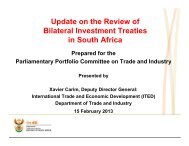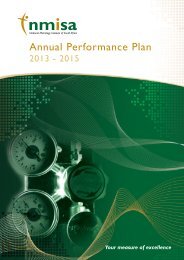Copyright Review Commission Report - ICT Law and Regulation ...
Copyright Review Commission Report - ICT Law and Regulation ...
Copyright Review Commission Report - ICT Law and Regulation ...
- No tags were found...
You also want an ePaper? Increase the reach of your titles
YUMPU automatically turns print PDFs into web optimized ePapers that Google loves.
5.3.14. The WIPO paper, Collective Management of <strong>Copyright</strong> <strong>and</strong> Related Rights, clearly defines the reasons forcollective management. It states that the fabric of our cultural lives is enriched by the genius of creators. In orderto develop their talent <strong>and</strong> encourage them to create, we have to ensure that incentives are available, namelyremuneration, in return for permission to make use of their works. The membership of the collectivemanagement organisation is open to all owners of copyright <strong>and</strong> related rights, being: authors composers publishers writers photographers musicians5.3.15. The collective management organisation allows for the use of works <strong>and</strong> for payment for their use to be made tothe correct owners of the right. The works declared by the organisation’s members are the national or localrepertoire. The WIPO paper illustrates the work of collective management, from traditional organisations torights clearance centres <strong>and</strong> one-stop shops. It also touches on the field of musical works, wheredocumentation, licensing <strong>and</strong> distribution are the three pillars on which the collective management of the rightsof public performance <strong>and</strong> broadcasting is based. Taking into account the national treatment principle enshrinedin both the Berne <strong>and</strong> Rome conventions, foreign rights owners are treated in the same way as nationals in theirrespective countries.5.3.16. The paper also makes the point that one of WIPO’s aims is to assist developing countries, upon their request, inestablishing collective management organisations, <strong>and</strong> to strengthen existing organisations to ensure that theyare fully efficient <strong>and</strong> effective in their response to the challenges of the digital environment.5.3.17. It deals with the socioeconomic <strong>and</strong> cultural dimension, service to the world of music <strong>and</strong> other creative arts.The system is rewarding the creators for their work <strong>and</strong> they, in turn, are more inclined to develop <strong>and</strong> applytheir talents in an environment that provides adequate copyright <strong>and</strong> related rights protection <strong>and</strong> an efficientsystem for the management of those rights. It is undeniable that these factors have a favourable impact onnational economies. Cultural industry contribution to the Gross Domestic Product <strong>and</strong> income from the collectivemanagement of copyright <strong>and</strong> related rights account for a substantial part of the percentage.6 LEVEL OF COLLECTING SOCIETIES’ COMPLIANCE WITH REGULATIONS6.1 ACCREDITED COLLECTING SOCIETIES6.1.1. Since the promulgation of Collecting Society <strong>Regulation</strong>s in 2006, the Registrar of <strong>Copyright</strong> accredited threesocieties to collect royalties for sound recordings, namely SAMPRA, SARRAL <strong>and</strong> SAMRO. In 2010, theaccreditation for SARRAL was withdrawn after the court issued a liquidation order in 2009.6.1.2. SAMRO <strong>and</strong> SARRAL were accredited as collecting societies for performers based on <strong>Regulation</strong> 3 (1) (b) <strong>and</strong>SAMPRA was accredited as a collecting society for the copyright owners in 2008 based on <strong>Regulation</strong> 3 (1) (a).- 43 -





